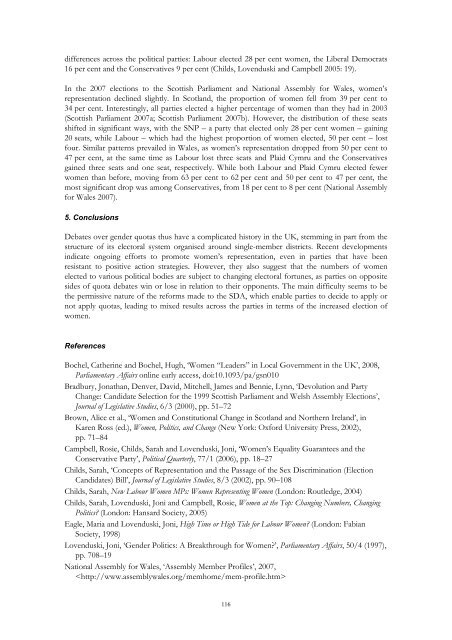Electoral gender quotas systems and their implementation in Europe
Electoral gender quotas systems and their implementation in Europe
Electoral gender quotas systems and their implementation in Europe
Create successful ePaper yourself
Turn your PDF publications into a flip-book with our unique Google optimized e-Paper software.
differences across the political parties: Labour elected 28 per cent women, the Liberal Democrats16 per cent <strong>and</strong> the Conservatives 9 per cent (Childs, Lovenduski <strong>and</strong> Campbell 2005: 19).In the 2007 elections to the Scottish Parliament <strong>and</strong> National Assembly for Wales, women’srepresentation decl<strong>in</strong>ed slightly. In Scotl<strong>and</strong>, the proportion of women fell from 39 per cent to34 per cent. Interest<strong>in</strong>gly, all parties elected a higher percentage of women than they had <strong>in</strong> 2003(Scottish Parliament 2007a; Scottish Parliament 2007b). However, the distribution of these seatsshifted <strong>in</strong> significant ways, with the SNP – a party that elected only 28 per cent women – ga<strong>in</strong><strong>in</strong>g20 seats, while Labour – which had the highest proportion of women elected, 50 per cent – lostfour. Similar patterns prevailed <strong>in</strong> Wales, as women’s representation dropped from 50 per cent to47 per cent, at the same time as Labour lost three seats <strong>and</strong> Plaid Cymru <strong>and</strong> the Conservativesga<strong>in</strong>ed three seats <strong>and</strong> one seat, respectively. While both Labour <strong>and</strong> Plaid Cymru elected fewerwomen than before, mov<strong>in</strong>g from 63 per cent to 62 per cent <strong>and</strong> 50 per cent to 47 per cent, themost significant drop was among Conservatives, from 18 per cent to 8 per cent (National Assemblyfor Wales 2007).5. ConclusionsDebates over <strong>gender</strong> <strong>quotas</strong> thus have a complicated history <strong>in</strong> the UK, stemm<strong>in</strong>g <strong>in</strong> part from thestructure of its electoral system organised around s<strong>in</strong>gle-member districts. Recent developments<strong>in</strong>dicate ongo<strong>in</strong>g efforts to promote women’s representation, even <strong>in</strong> parties that have beenresistant to positive action strategies. However, they also suggest that the numbers of womenelected to various political bodies are subject to chang<strong>in</strong>g electoral fortunes, as parties on oppositesides of quota debates w<strong>in</strong> or lose <strong>in</strong> relation to <strong>their</strong> opponents. The ma<strong>in</strong> difficulty seems to bethe permissive nature of the reforms made to the SDA, which enable parties to decide to apply ornot apply <strong>quotas</strong>, lead<strong>in</strong>g to mixed results across the parties <strong>in</strong> terms of the <strong>in</strong>creased election ofwomen.ReferencesBochel, Cather<strong>in</strong>e <strong>and</strong> Bochel, Hugh, ‘Women “Leaders” <strong>in</strong> Local Government <strong>in</strong> the UK’, 2008,Parliamentary Affairs onl<strong>in</strong>e early access, doi:10.1093/pa/gsn010Bradbury, Jonathan, Denver, David, Mitchell, James <strong>and</strong> Bennie, Lynn, ‘Devolution <strong>and</strong> PartyChange: C<strong>and</strong>idate Selection for the 1999 Scottish Parliament <strong>and</strong> Welsh Assembly Elections’,Journal of Legislative Studies, 6/3 (2000), pp. 51–72Brown, Alice et al., ‘Women <strong>and</strong> Constitutional Change <strong>in</strong> Scotl<strong>and</strong> <strong>and</strong> Northern Irel<strong>and</strong>’, <strong>in</strong>Karen Ross (ed.), Women, Politics, <strong>and</strong> Change (New York: Oxford University Press, 2002),pp. 71–84Campbell, Rosie, Childs, Sarah <strong>and</strong> Lovenduski, Joni, ‘Women’s Equality Guarantees <strong>and</strong> theConservative Party’, Political Quarterly, 77/1 (2006), pp. 18–27Childs, Sarah, ‘Concepts of Representation <strong>and</strong> the Passage of the Sex Discrim<strong>in</strong>ation (ElectionC<strong>and</strong>idates) Bill’, Journal of Legislative Studies, 8/3 (2002), pp. 90–108Childs, Sarah, New Labour Women MPs: Women Represent<strong>in</strong>g Women (London: Routledge, 2004)Childs, Sarah, Lovenduski, Joni <strong>and</strong> Campbell, Rosie, Women at the Top: Chang<strong>in</strong>g Numbers, Chang<strong>in</strong>gPolitics? (London: Hansard Society, 2005)Eagle, Maria <strong>and</strong> Lovenduski, Joni, High Time or High Tide for Labour Women? (London: FabianSociety, 1998)Lovenduski, Joni, ‘Gender Politics: A Breakthrough for Women?’, Parliamentary Affairs, 50/4 (1997),pp. 708–19National Assembly for Wales, ‘Assembly Member Profiles’, 2007,116






